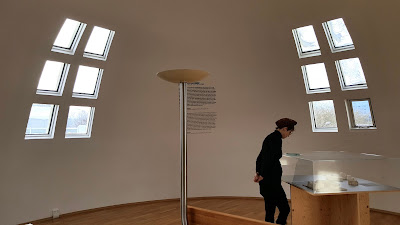The Asmundarsafn Museum is one of three buildings, along with the Kjarvalsstadir which I wrote about in my last post, that make up the Reykjavik Art Museum. It is the former home and studio of sculptor Asmundur Sveinsson.
The building was designed by the artist. Two truncated pyramids flank the entrance, at the center is the dome and at the rear, now joined to the rest of the building, but once separate, is a crescent shaped room with skylights. He was inspired to use the dome form by the villas of Greece, a country that like Iceland, lacks trees, so does not use wood extensively in its buildings. The pyramids he said, were inspired by ancient Egypt, and the crescent shape a practical solution to store his materials at the rear.
The building was designed by the artist. Two truncated pyramids flank the entrance, at the center is the dome and at the rear, now joined to the rest of the building, but once separate, is a crescent shaped room with skylights. He was inspired to use the dome form by the villas of Greece, a country that like Iceland, lacks trees, so does not use wood extensively in its buildings. The pyramids he said, were inspired by ancient Egypt, and the crescent shape a practical solution to store his materials at the rear.
This charming lamp, one of a pair, lights steps inside the entry hall. It is an example of Asmundur's early sculpture. More figurative stone sculptures can be seen on the grounds of the museum. At the time I was there, they were blanketed in snow, so I confined my visit to the indoor spaces.
There is no resemblance to a home in the present day, despite the free coffee by the gift shop. The overall impression to me of this museum is a kind of pure, minimalist grandeur on a small scale.
There is no resemblance to a home in the present day, despite the free coffee by the gift shop. The overall impression to me of this museum is a kind of pure, minimalist grandeur on a small scale.
Asmundur's studio, I was informed, was directly under the dome, though I am unclear if a second level was then in use.
This second floor space pictured here seems impractical to me. How would large sculptures be moved out of the studio? I saw no elevator or outside doors, just a staircase of average dimensions. I should have asked.

Two crescent-shaped rooms made wonderful light filled gallery spaces for the sculptors later work. Abstract sculptures in cast metal and also sculptural assemblages of metal rods and wire occupied plinths on the marble floor.

On the walls drawings and collages by the artist were equally interesting to me. Some appear to be working sketches with pencil underdrawings clearly visible under ink and paint.
Looking at the sculpture of the blacksmith above, and then at the sculptures in the following photographs, one can see the progression of Asmundur's work from blocky semi-realistic figures to pure abstraction. In his work we see the big changes that occurred in western art in the 20th century.
 |
| Time, 1952 |
Asmundur appears to have been born at the right time, a time when art was being freed from the strictures of realistic rendering and mimicry of form. In his own words:
"I think I was always destined for abstract art, even if I didn't realise it myself. Even when I painted nature I was always more concerned with the composition than the subject being painted."







No comments:
Post a Comment
please leave feedback. thanks!